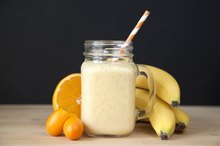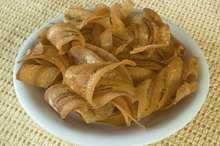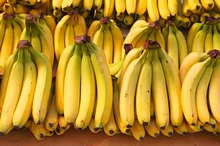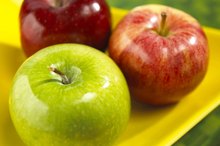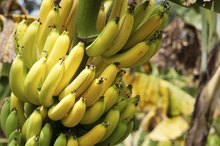Is Eating a Banana With Brown Spots Bad for You?
The bright yellow hue of a banana may seem ruined when it develops brown spots. Your first instinct may be to throw away any discolored bananas. However, the appearance of brown spots does not destroy this highly nutritious and portable fruit, that is readily available year round.
Ripening Process
Unlike fruits that need to ripen on the tree or plant, growers pick bananas that are firm, green and fleshy. Once the fruit leaves the tree, amino acids inside began to change to ethylene gas. This gas eventually ripens the banana. The enzymes soften the banana, sweeten the fruit and change the color from green to yellow. Growers often ship bananas long distances, and thicker, tougher peel of green, unripened bananas often makes the journey with less damage. Some growers add ethylene gas to ripen bananas more quickly if they are close to the marketplace.
- Unlike fruits that need to ripen on the tree or plant, growers pick bananas that are firm, green and fleshy.
Brown Spots from Ripening
How to Avoid a Bitter Banana Taste in a Smoothie
Learn More
As the banana ripens, brown spots generally develop as it moves through the ripening stage. The sugar content in the banana increases from almost zero to about 80 percent as the banana ripens, according to Kathy Wollard, author of Newsday's “How Come?” The more brown spots the banana has, the more sugar the banana contains, and the sweeter it becomes 3. Brown spots on a banana generally do not indicate disease. Bananas with spots should be safe to eat.
- As the banana ripens, brown spots generally develop as it moves through the ripening stage.
- The sugar content in the banana increases from almost zero to about 80 percent as the banana ripens, according to Kathy Wollard, author of Newsday's “How Come?”
Additional Causes
Although brown spots on bananas are often a result of the ripening process, you may encounter a banana that has long brown streaks and appears split. This condition, caused by too much humidity during the ripening process, may make the banana inedible. Plant pathologist Scot Nelson at the University of Hawaii says that small brown flecks on the banana’s peel may be an indication of senescent spots 2. These spots develop from already mature fruit spending time in a specialized ripening facility. Bananas with senescent spots are safe to eat. If you put your bananas in the refrigerator for longer than one day, Nelson says you may injure the bananas skin and cause dark areas to form. Of course, sometimes brown spots occur from bruising from rough handling. These bruises are harmless and don't make the banana inedible.
- Although brown spots on bananas are often a result of the ripening process, you may encounter a banana that has long brown streaks and appears split.
- This condition, caused by too much humidity during the ripening process, may make the banana inedible.
Uses
How to Dehydrate Bananas in a Food Dehydrator
Learn More
The high sugar content of bananas with brown spots makes them good for use in baking. Using very ripe bananas often means you can reduce the amount of sugar in recipes for banana bread, muffins and cakes. Other options for very ripe bananas include mashing the fruit and freezing them in quart-sized bags. You can use the puree in smoothies or baked goods. If you are trying to eat a nutritionally balanced diet, one banana counts as a serving of fruit. A 7-inch 118-gram banana has about 105 calories, making it a good choice if you try to limit your snacks to the 100-calorie range.
- The high sugar content of bananas with brown spots makes them good for use in baking.
- A 7-inch 118-gram banana has about 105 calories, making it a good choice if you try to limit your snacks to the 100-calorie range.
Related Articles
References
- USDA Economic Research Service: Fresh-Market Bananas -- Background Statistics and Information
- University of Hawaii: Banana Ripening -- Principles and Practice
- “How Come?”; Kathy Wollard; 2007
- USDA National Nutrient Database for Standard Reference: Bananas, Raw
- Bananas, raw. FoodData Central. U.S. Department of Agriculture. Published April 1, 2019.
- Glycemic index for 60+ foods. Harvard Health Publishing, Harvard Medical School. Updated 2020.
- Nutritional Goals for Age-Sex Groups Based on Dietary Reference Intakes and Dietary Guidelines Recommendations. USDA. 2015
- Falcomer AL, Riquette RFR, De lima BR, Ginani VC, Zandonadi RP. Health benefits of green banana consumption: A systematic review. Nutrients. 2019;11(6). doi:10.3390/nu11061222
- Klemm S. Prebiotics and probiotics: Creating a healthier you. Academy of Nutrition and Dietetics. Updated 2020.
- Howarth NC, Saltzman E, Roberts SB. Dietary fiber and weight regulation. Nutr Rev. 2001;59(5):129-39. doi:10.1111/j.1753-4887.2001.tb07001.x
- Pereira A, Maraschin M. Banana (Musa spp) from peel to pulp: ethnopharmacology, source of bioactive compounds and its relevance for human health. J Ethnopharmacol. 2015;160:149-63. doi: 10.1016/j.jep.2014.11.008
- Vitamin C: Fact Sheets for Health Professionals. National Institutes of Health, Office of Dietary Supplements. Updated 2020.
- Hassan AK, Venkatesh YP. An overview of fruit allergy and the causative allergens. Eur Ann Allergy Clin Immunol. 2015;47(6):180-7.
- Manohar M, Verma AK, Upparahalli Venkateshaiah S, Goyal H, Mishra A. Food-induced acute pancreatitis. Dig Dis Sci. 2017;62(12):3287-3297. doi:10.1007/s10620-017-4817-2
Writer Bio
Diane Lynn began writing in 1998 as a guest columnist for the "Tallahassee Democrat." After losing 158 pounds, she wrote her own weight-loss curriculum and now teaches classes on diet and fitness. Lynn also writes for The Oz Blog and her own blog, Fit to the Finish. She has a Bachelor of Science in finance from Florida State University.
